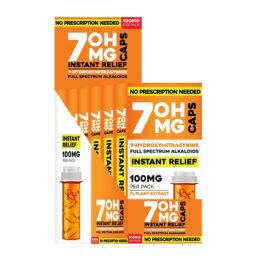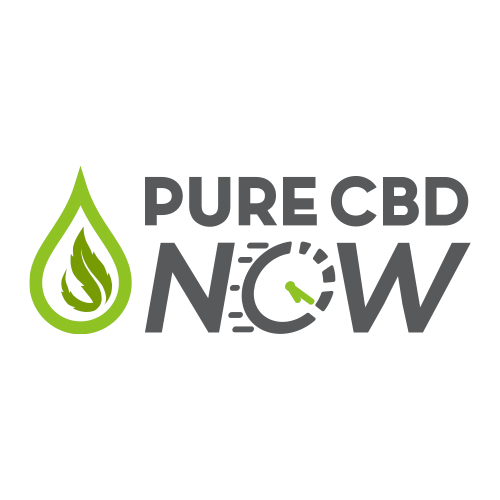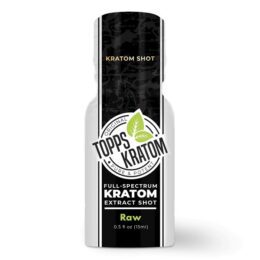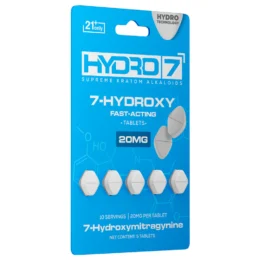Is Kratom An Opioid? Understanding Its Classification
Discover amazing products designed just for you.
Featured Products

7-OHMG Softgel Caps 100mg Per Pack | 6-pack
Original price was: $299.00.$249.00Current price is: $249.00.
Add to cartWhat Exactly Is Kratom And How Does It Work?
Kratom, scientifically known as Mitragyna speciosa, is a tropical tree native to Southeast Asia. The leaves of this tree have been used for centuries in traditional medicines for their stimulant and sedative properties. Kratom contains several active compounds, with mitragynine and 7-hydroxymitragynine being the most prominent. These compounds interact with the body’s opioid receptors,1 albeit in a much different manner than traditional opioids.
When kratom is consumed, it can produce effects that vary significantly depending on the dosage. It acts as a stimulant in smaller amounts, potentially increasing energy and alertness. Conversely, higher doses may impart sedative effects, leading to a state of relaxation or euphoria, which is often associated with traditional opioid use. This dual-action behavior is what sparks the debate around kratom’s classification.
Is Kratom An Opioid? Unveiling The Truth Behind The Misconception
Kratom’s classification is a frequent source of confusion. Many people mistakenly believe it’s an opioid, but that’s not accurate. While kratom interacts with opioid receptors,1 it’s not chemically related to opioids and has a distinct pharmacological profile.
How Kratom Works: The Receptor Interaction
Kratom’s alkaloids, particularly mitragynine, bind to opioid receptors. This is similar to how opioid drugs function. However, the way kratom interacts with these receptors differs significantly from traditional opioids. Mitragynine is a partial agonist at the mu-opioid receptor, meaning it activates the receptor, but not as strongly as a full agonist like morphine. This difference in activation is believed to contribute to kratom’s distinct effects. Furthermore, kratom interacts with other brain receptors beyond the opioid system, contributing to its complex and varied effects.
Why Kratom Is Not Classified As An Opioid
Despite its interaction with opioid receptors, kratom is not classified as an opioid for several key reasons:
- Different Chemical Structure: Kratom’s alkaloids have a distinct chemical structure, entirely different from opioid drugs. They are not chemically related.
- Different Effects Profile: Kratom’s effects are more complex than typical opioids. While it may potentially offer pain-easing effects,2 it also exhibits stimulating effects, particularly at lower doses. This duality is not characteristic of opioids.
- Lower Risk Of Respiratory Depression: Respiratory depression, a potentially fatal side effect of opioid overdose,3 is a much lower risk with kratom, especially when used responsibly. This is likely due to its partial agonist activity.
- Less Severe Withdrawal: While kratom use may lead to dependence and withdrawal symptoms, these are generally less severe and shorter-lived than those associated with opioid withdrawal.
How Kratom Differs From Traditional Opioids: Key Differences You Should Know
When examining whether kratom is an opioid, it’s essential to understand how it differs from traditional opioids. Although kratom and opioids may share some overlapping effects, such as easing pain and sedation, there are distinct differences in their composition, origin, and impact on the human body.
Origin And Composition
Kratom is derived from the leaves of the Mitragyna speciosa tree, native to Southeast Asia. This botanical origin contrasts with many traditional opioids, which are either synthesized in laboratories or extracted from the opium poppy. The primary active compounds in kratom, mitragynine and 7-hydroxymitragynine, act on the opioid receptors in the brain but do so in a different way and with varying potency compared to synthetic opioids like oxycodone.
Legal Status
While conventional opioids are primarily regulated substances prescribed for pain management, kratom’s legal status varies significantly across different regions. In the United States, for instance, kratom is not classified as a controlled substance at the federal level, although some states and municipalities have imposed restrictions. This difference in regulatory status highlights the ongoing debate about kratom’s classification and its potential benefits versus risks.
Risk Of Dependency
Both kratom and traditional opioids have the potential for dependency; however, the nature and extent of this risk can differ. Opioids are commonly associated with a high risk of dependency and addiction, which has been a significant factor in the opioid crisis. While some users report developing dependency on kratom, the data suggests it may have a lower risk profile than conventional opioids.4 Nonetheless, individual responses to kratom may vary, underscoring the importance of cautious use.
Side Effects
The side effects of kratom diverge from those typically associated with opioids. While both can cause nausea, constipation, and lethargy, kratom users have also reported experiencing effects such as increased energy or heightened alertness at lower doses, which are not usually associated with opioid consumption. This dual nature adds complexity to kratom’s classification and its perceived benefits.
Are Kratom And Opioids Addictive? The Facts You Need To Consider
Understanding the addiction potential of both kratom and opioids is crucial, especially as both substances are often compared due to their effects on the brain.
Addiction Mechanics
Opioids are well-documented for their highly addictive nature, posing serious risks of dependence and withdrawal symptoms. These substances work by binding to opioid receptors, leading to an increased release of dopamine, which is often referred to as the “feel-good” neurotransmitter. As the brain becomes accustomed to these elevated levels of dopamine, dependence and addiction can quickly develop.
While kratom works on the same receptors, its potential for addiction appears to be less pronounced. However, it is not devoid of risk. Regular, high-dose usage can lead to tolerance, dependence, and even withdrawal symptoms upon cessation. The extent of these risks largely depends on the frequency of use and individual physiology.
Responsible Use And Education
At Pure CBD Now, we are committed to providing educational resources to empower our customers to make informed decisions about their wellness choices. For those considering kratom as an alternative remedy, it’s imperative to use it responsibly and stay informed about its effects. Our dedication to transparency and safety includes offering kratom products that undergo rigorous third-party lab testing, ensuring they’re both potent and free from contaminants.
Health Risks Of Kratom: Is It Safer Than Opioids For Easing Pain?
Although it is not classified as an opioid, kratom interacts with the same receptors in the brain, resulting in similar potential pain-easing effects. Understanding its safety profile compared to opioids is crucial for making informed decisions about its use.
Potential Health Risks
Kratom’s safety is a concern due to its psychoactive properties and potential for dependency. While many users report positive experiences, such as improved mood and reduced pain, some studies suggest that kratom can lead to side effects like nausea, sweating, itchiness, dry mouth, constipation, loss of appetite, and, in some cases, an increased likelihood of addiction.
Comparing Kratom And Opioids
Opioids are well-documented for their effectiveness in pain management but are equally notorious for their high addiction potential and overdose risk. In comparison, kratom is often marketed as a safer alternative, yet it’s essential to weigh the lack of comprehensive long-term studies on its consumption.
The potential for kratom as a less addictive substitute to opioids is intriguing, especially given the opioid crisis affecting many communities. However, both substances require cautious use, with consideration of the user’s health profile and potential drug interactions.
Is Kratom Legal? The Legal Status Of Kratom Compared To Opioids
The legality of kratom is complex and varies significantly depending on location. It’s crucial to understand that while kratom interacts with some of the same brain receptors as opioids, it is not an opioid, and its legal status reflects this distinction (though sometimes, unfortunately, it doesn’t).
Kratom’s Legal Status:
- Varies Widely: Kratom’s legality ranges from completely legal to completely banned, with many areas having regulations somewhere in between. There is no universal consensus on its regulation.
- Federal Level (USA): At the federal level in the United States, kratom is not currently a controlled substance. However, the FDA has issued warnings about kratom, and its legal status could change. Some states and local jurisdictions have enacted their laws regarding kratom.
- State And Local Laws (USA): Many states and cities in the US have banned or regulated kratom. It’s essential to check the specific laws in your area.
- International Laws: The legal status of kratom varies widely internationally. Some countries have banned it, while others regulate it or allow its sale.
Opioids’ Legal Status:
- Controlled Substances: Opioids, on the other hand, are generally controlled substances. This means their production, distribution, and use are heavily regulated due to their high potential for abuse and addiction.
- Prescription Required: Many opioids require a prescription from a doctor for legal use.
- Strict Regulations: Even legal opioids are subject to strict regulations regarding their manufacture, sale, and dispensing.
Critical Differences In Legal Status:
- Kratom’s Unclear Status: Kratom’s legal status is often unclear and subject to change. This makes it difficult for consumers and businesses to navigate the legal landscape.
- Opioids’ Controlled Status: Opioids are clearly defined as controlled substances with strict regulations.
- Reasons For Kratom Bans: Kratom bans are often based on concerns about its potential for abuse, despite it not being an opioid and a lack of extensive long-term research. Misinformation and conflation with opioids also play a role.
Why The Distinction Matters:
It’s important to understand that kratom is not an opioid when considering its legal status. While both interact with similar brain receptors, they are distinct substances with different chemical structures, effects, and risks. Laws that treat kratom as an opioid are often misinformed and fail to recognize these crucial differences.
Should You Choose Kratom Over Opioids? What You Need To Know Before Using Kratom
Here’s what you need to know before choosing kratom over opioids.
Understanding Opioid Risks
Opioids, while effective for potentially easing pain, are highly addictive and carry risks such as dependence, tolerance, and overdose. Their narrow therapeutic window makes misuse easy, contributing to the ongoing opioid crisis.
What Is Kratom?
Kratom is a natural herb that interacts with opioid receptors in the brain, offering effects like easing pain or bringing mild euphoria. While it may serve as a milder substitute, it is not as potent or extensively researched as prescription opioids.
Kratom As An Alternative To Opioids
Many use kratom to manage pain or ease opioid withdrawal.5 It may potentially help ease pain with fewer risks of overdose, but it’s not a substitute for medical treatment, and regular use can lead to dependence.
Benefits Of Kratom
- Lower overdose risk: Less potent than opioids.
- Withdrawal aid: Helps manage opioid withdrawal symptoms.5
- Natural: Appealing to those seeking plant-based remedies.
Risks Of Kratom Use
Kratom isn’t without dangers, including:
- Dependence: Regular use can lead to tolerance and withdrawal.
- Side effects: Nausea, dizziness, and, in rare cases, liver toxicity.
- Lack of regulation: Kratom products aren’t FDA-regulated, risking contamination.
Consult A Healthcare Provider
Before using kratom, consult your healthcare provider. They can guide you through opioid tapering or recommend alternative treatments. Kratom should not replace professional medical care.
Read Also:
- Is Kratom Considered A Drug? Legal And Scientific Insights
- Is Kratom Safe? Benefits And Risks Explained
- Legal Alternatives To Kratom: Safe Options
Sources:
- Annuar, Ummi Kalthum Azlan, Mediani, A., Tong, X., Han, R., Ebtesam Al-Olayan, Syarul Nataqain Baharum, Hamidun Bunawan, Murni Nazira Sarian, Hamizah Shahirah Hamezah, & Ibrahim Jantan. (2024). An insight review on the neuropharmacological effects, mechanisms of action, pharmacokinetics and toxicity of mitragynine. Biomedicine & Pharmacotherapy, 171, 116134–116134. https://doi.org/10.1016/j.biopha.2024.116134
- Kruegel, A. C., Uprety, R., Grinnell, S. G., Langreck, C., Pekarskaya, E. A., Le Rouzic, V., Ansonoff, M., Gassaway, M. M., Pintar, J. E., Pasternak, G. W., Javitch, J. A., Majumdar, S., & Sames, D. (2019). 7-Hydroxymitragynine Is an Active Metabolite of Mitragynine and a Key Mediator of Its Analgesic Effects. ACS Central Science, 5(6), 992–1001. https://doi.org/10.1021/acscentsci.9b00141
- Schiller, E. Y., & Mechanic, O. J. (2023). Opioid overdose. National Library of Medicine. https://www.ncbi.nlm.nih.gov/books/NBK470415/
- Henningfield, J. E., Wang, D. W., & Huestis, M. A. (2022). Kratom Abuse Potential 2021: An Updated Eight Factor Analysis. Frontiers in Pharmacology, 12. https://doi.org/10.3389/fphar.2021.775073
- Prevete, E., Hupli, A., Marrinan, S., Singh, D., Udine, B. D., Bersani, G., Kuypers, K. P. C., Ramaekers, J. G., & Corazza, O. (2021). Exploring the use of Kratom (Mitragyna speciosa) via the YouTube data tool: A novel netnographic analysis. Emerging Trends in Drugs, Addictions, and Health, 1, 100007. https://doi.org/10.1016/j.etdah.2021.100007
Frequently Asked Questions About Is Kratom An Opioid? Understanding Its Classification
How is Kratom classified legally in the United States?
Kratom’s legal classification varies by state and locality within the United States. While it is federally legal as a substance, some states have banned its sale and use. Be sure to check local regulations before purchasing or consuming Kratom.
How is Kratom consumed?
Kratom is commonly consumed in various forms, including capsules, powders, teas, and extracts. Some people prefer to chew on the fresh leaves, while others might brew the dried leaves into tea or mix the powder into beverages for easier consumption.
What are the potential side effects of Kratom?
Kratom use can lead to several side effects, ranging from mild to severe. Common side effects include nausea, constipation, and dizziness. Always use Kratom cautiously and under guidance.
Is Kratom safe to use?
The safety of Kratom largely depends on the dosage and frequency of use. While many users report beneficial effects when used responsibly, due to the risk of addiction and other side effects, it is essential to exercise caution. Consulting a healthcare professional before use is advised.
What is the recommended dosage for Kratom?
The recommended dosage of Kratom varies depending on several factors, including the user’s body weight, tolerance, and the intended effect. Generally, beginners should start with smaller doses, around 1 gram to 5 grams, and gradually increase as needed. Always adhere to dosage guidelines provided by the supplier.
Is it legal to buy Kratom online?
In regions where Kratom is legal, it is possible to purchase it online from reputable retailers like Pure CBD Now. However, legality can vary, so it’s essential to verify the local laws in your area before making a purchase. Ensure that product quality is verified through third-party lab testing where available.









